Kumbha Mela is the world’s largest religious fair. It is not only a display of supremacy of the Bharatiya culture, but is also a spiritual congregation that provides satsang. The Kumbha Mela held every 12 years at Prayag, Haridwar, Ujjain and Tryambakeshwar-Nashik on the occasion of the Kumbha Parva has an important place in the Hindu civilization. The spiritual glory and cultural importance of the Kumbha Parva is unique.
1. Prayag (Allahabad)
This pilgrimage place is located on the sacred ‘Triveni Sangam’, that is, the place where the three rivers, Ganga, Yamuna and Saraswati, congregate in Uttar Pradesh. Ganga and Yamuna are visible; but Saraswati is invisible. Due to this sacred confluence, the place is referred to as ‘Prayagraj’ or ‘Tirtharaj’.
1A. Origin and meaning
The word ‘Prayag’ comes from ‘Pra’ as a prefix and the root ‘Yaj’. Its meaning is – to hold a big Yadnya (Sacrificial fire). In the Skandapurana it is mentioned that for all types of Yadnya, Prayag is the best place; therefore, it is called ‘Prayag’. Being so meaningful and as ancient as the Vedas (The most sacred Hindu scriptures revealed directly by God), this place should be called ‘Prayag’ by the devotees instead of calling it ‘Allahabad’, which is a name given by foreign invaders.
1B. Significance of the place
A. Prajapatikshetra : After receiving the the four Vedas that had been lost, Prajapati performed a huge Yadnya here; hence, Prayag is also called ‘Prajapatikshetra’.
B. Madhyavedi of the five Yadnyavedis : Of the five Yadnya-vedis (Pits where Yadnya is performed) – Kurukshetra, Gaya, Viraj, Pushkar and Prayag, Prayag is the madhyavedi (The vedi [Pit for Yadnya] in the centre).
C. One of the three pilgrimage places : Prayag, one of the three pilgrimage places of Kashi, Prayag and Gaya, is unique from religious perspective.
D. Safe place during Pralaya : Prayag is ‘Akshaya kshetra’. The entire world will be submerged in the massive floods during the Pralaya (Dissolution of the world); but not Prayag. At the end of Pralaya, Shrivishnu will sleep on the Akshayavata in Prayag in the form of a child. Similarly, all the Gods, Sages and spiritually evolved individuals will reside here and protect the place. This is the signifi cance of the place.
2. Significance described in various scriptures
2A. Rugveda :
सितासिते सरिते यत्र सङ्गते तत्राप्लुतासो दिवमुत्पतन्ति ।
ये वै तन्वं विसृजन्ति धीरास्ते जनासो अमृतत्वं भजन्ते ॥
– Rugveda, Khilsukta
Meaning : He who bathes at the sangam (Confluence) of Ganga and Yamuna Rivers attains Heaven, and courageous individuals who sacrifice their body in this confl uence attain Moksha (Final Liberation).
2B. Padmapurana : Padmapurana says the following about Prayagraj.
ग्रहाणां च यथा सूर्यो नक्षत्राणां यथा शशी ।
तीर्थानामुत्तमं तीर्थं प्रयागाख्यमनुत्तमम् ॥
Meaning : Just as the sun is supreme among all celestial bodies (As per astrology), the moon in the constellation (As per astrology),
Prayagraj is supreme among all pilgrimage places.
2C. Kurmapurana : Prayag is the superior most pilgrimage place in all the three lokas.
2D. Mahabharat :
यागः सर्वतीर्थेभ्यः प्रभवत्यधिकं विभो ॥
श्रवणात् तस्य तीर्थस्य नामसंकीर्तनादपि ।
मृत्तिकालम्भनाद्वापि नरः पापात् प्रमुच्यते ॥
– Mahabharat, Parva 3, Adhyaya 83, Shloka 74, 75
Meaning : O King ! Prayag is the superiormost among all pilgrimage places. If its greatness is heard, its Name is chanted or if its soil is smeared on the body, man will be liberated from all sins.
3. Rites at pilgrimage places
While on pilgrimage to Prayagraj, the essential rites to be performed are worshipping the Triveni Sangam, tonsuring, taking a Holy dip in the River Ganga, Pitrushraddha, offering of hair by married women and darshan of the Deities.
4. Sthandarshan (Visiting the place)
A shloka on darshan of places in Prayag says,
त्रिवेणीं माधवं सोमं भरद्वाजं च वासुकिम् ।
वन्देऽक्षयवटं शेषं प्रयागं तीर्थनायकम् ॥
Meaning : I pay obeisance to Triveni (Sangam), Venimadhav, Someshwar, Bhardwaj, Vasuki serpent, Akshayavat, Shesha (Baldev) and king of pilgrimage places, Prayag.
4A. Triveni Sangam
The flows of Ganga, Yamuna and Saraswati merge into each other like the 3 strands in a hair plait.
4B. Madhav
This is Madhavakshetra (Place of Madhav) and there are 12 Madhavas; for example, Venimadhav (Principal Madhav), Shankhamadhav, Manoharamadhav etc.
4C. Someshwar (Deity Shiva)
This Shiva Temple is near Bindumadhav at Arail village on the other side of River Yamuna.
4D. Bhardwaj and Shesha
The Ashram of Sage Bharadwaj is situated here. The Shivalinga in this Ashram is called ‘Bharadwajeshwar’. There is an Idol of Shesha serpent with one thousand hoods in this temple.
4E. Vasukishwar (King of the serpents)
The Vasuki Temple is on the banks of the River Ganga here (In Bakshi Peth).
4F. Akshayavat
This is the ancient and sacred banyan tree and is situated on the banks of Yamuna in Prayag. The roots of Akshayavat (which is an abode for all Deities) go deep down till Patal (Hell region). The Puranas (The eighteen sacred Holy texts compiled by Sage Vyas) of Vayu, Matsya, Kurma, Padma, Agni and Skanda say that one attains Moksha (Final liberation) by sacrifi cing the body near the Akshayavat.
4F 1. Akbar and his son Jahangir destroyed the Akshayavat and built a fort with the intention to thwart the effort of Hindus to attain Moksha : In the beginning of the 17 th Century, under the pretext of building a fort to protect the banks of Yamuna at Prayag, the Mughal emperor Akbar destroyed Akshayavat and the adjoining temples. He built ‘Ranimahal’ where the Akshayavat existed. After some time, the Akshayavat grew again in the fort. Akbar’s son Jahangir tried to burn it many times. He even placed a hot iron plate to destroy the tree from the roots; but the Akshayavat kept sprouting every time and again it acquired the form of a giant tree. The Holy text ‘Khulasat Utvarikha’ of 1693 testifi es that Akshayavat sprouted again despite Jahangir chopping it off.
Even today, the ancient tree stands with pride in Akbar’s fort on the banks of Yamuna. To prevent Hindus from attaining Moksha, the Mughal emperors banned its darshan. Later, the English rulers continued with the ban. After Independence, the security of the place was increased since it housed the weapons depot of the Indian army. Permission was granted for darshan once a year during the Magha Mela and Kumbha Mela. At other times of the year, devotees were permitted to see the tree’s trunk from a distance. During the Kumbha Mela in 2013, the Indian Army took initiative and convinced the Defence Ministry to allow Hindus to have darshan of the Akshayavat. As a result, now it has become possible for the Hindus to go to the fort every day and have darshan of the Patalpuri Temple, Saraswati Well and the Akshayavat.
5. Prayag Kumbh Mela
Every 12 years, a Prayag Kumbh Mela is held at the Triveni Sangam of Ganga, Yamuna and Saraswati in Prayag. It is called ‘Mahakumbha Mela’. This Kumbha Parva comprises three Parvakals (Auspicious time) – Makar Sankranti, Maghi (Mouni) Amavasya and Vasant Panchami. The Maghi (Mouni) Amavasya is the principal Parva and is referred to as ‘Purnakumbha’. The Magha Pournima is also
considered as a Parva (Auspicious) time. A Holy dip in the Ganga has special signifi cance on the days of all the four Parvas. The Kumbha Mela comes every 12 years; every 6 years, the Kumbha Mela organised is called the ‘Ardha Kumbha Mela’.
5A. Magha Mela
A pilgrimage is held every year in the month of Magha on the sacred Triveni Sangam, which is called ‘Magha Mela’. Ascetics come here for a Holy bath on the new moon day in the month of Magha. According to the Padmapurana, it is extremely rare to have the privilege of a Holy bath in Prayag in the month of Magha. According to Agnipurana a Holy bath every day at Prayag is equivalent to the benefi t obtained by donating millions of cows; according to the Brahmapurana it is equal to performing Ashwamedha Yadnya and according to Matsyapurana, it is equal to the pilgrimage to more than 100 crore shrines. Mahabharata says that Deity Brahma Himself was unable to describe the benefi ts obtained by donations and a Holy bath on Makarsankranti at Prayag.
5B. Kalpavas – Spiritual practice during the Prayag Kumbh Mela
From Pousha Shukla Ekadashi to Magha Shukla Pournima, many Ascetics and devotees reside on the banks of Ganga in the month of Magha near the Triveni Sangam at Prayag. This is called ‘Kalpavas’. The residents during Kalpavas donate even their huts while returning home after the Magha month. The Puranas say that Kalpavas is Holy since it satisfies our ancestors, destroys sins and liberates us from the bondage of life and death. The scriptures say that Kalpavas in Prayag with deep faith and performing rituals is important and its benefits are imperishable. The scriptures say that people in Kalpavas should sleep on the ground, fast, bathe thrice a day, renounce worldly pleasures, control their senses and worship Shrivishnu. It is believed that the Kalpavas washes away all the sins. The Kalpavas devotees perform the ritual of tonsuring during the Kumbha Parva with a bhav (Spiritual emotion) of surrendering the intellect and mind to God.
5C. Prayagwal – Priests who perform rituals in the Prayag Kumbh Mela
These priests have the right to collect the offerings on the Triveni stairs and water, performing rituals of worship and arranging the Kumbha Melas. They make residential arrangements for the Kalpavas devotees. This is an ancient tradition and it fi nds a mention in the Matsyapurana. These priests also perform the ritual of worship at the time of immersing bones of dead bodies.
Reference : Sanatan Sanstha’s Holy text ‘Glory of the Kumbha Parva’

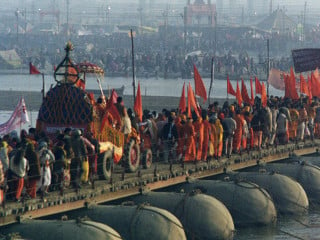
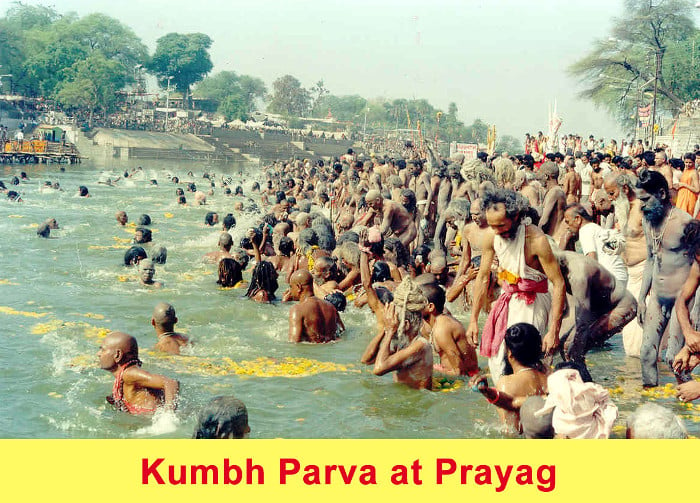
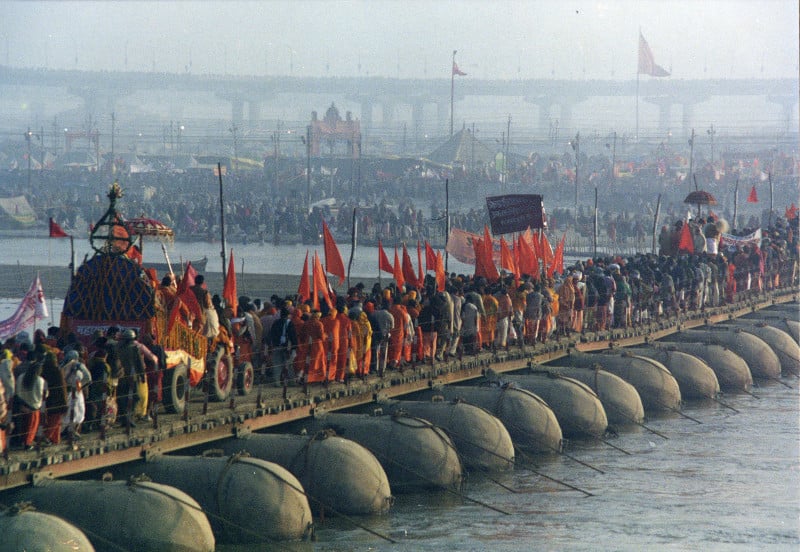
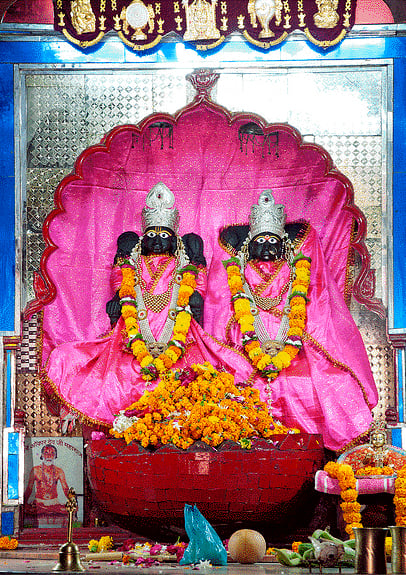
 Holy river
Holy river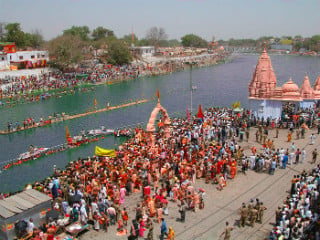 Bathing ghats located along Shipra River
Bathing ghats located along Shipra River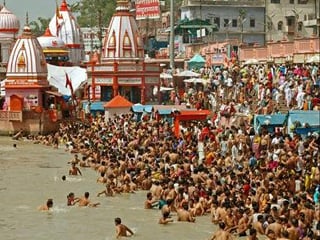 Main Bathing Dates for Kumbha Parva at Haridwar 2021
Main Bathing Dates for Kumbha Parva at Haridwar 2021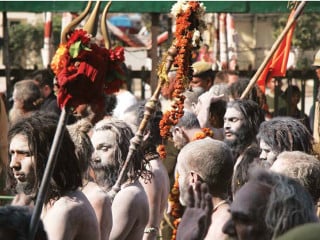 What is Akhada - List of Akhadas
What is Akhada - List of Akhadas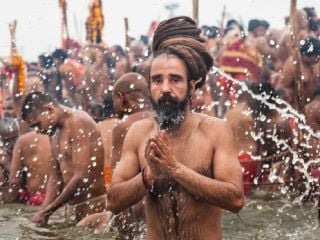 Shahi snan meaning and importance
Shahi snan meaning and importance